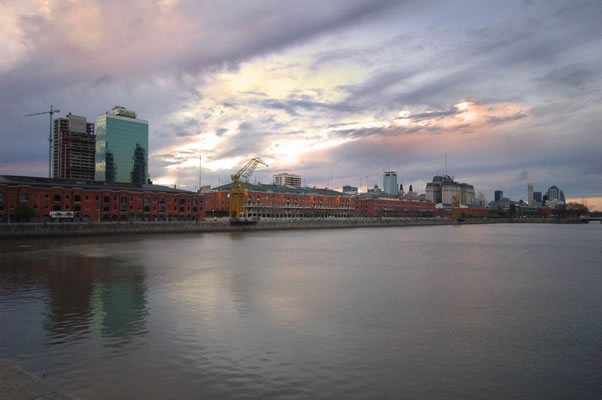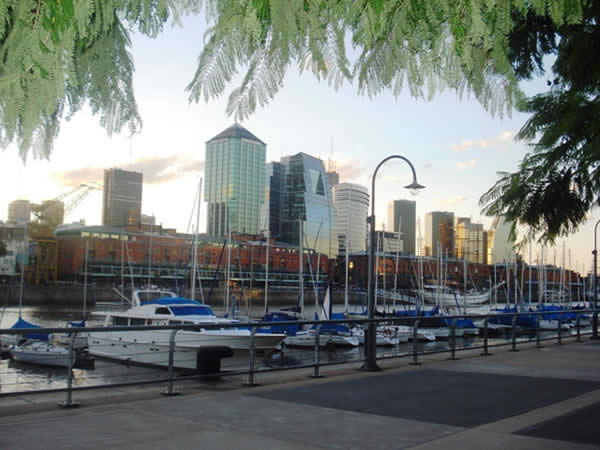 Puerto Madero is Buenos Aires’ ritzy prototype of modernity in a city otherwise beloved for its history.
Puerto Madero is Buenos Aires’ ritzy prototype of modernity in a city otherwise beloved for its history.
The city’s newest district, with its sleek high-rises, perfect sidewalks and well-equipped parks is considered one of the most successful urban waterfront restoration projects in the world. The long, narrow dockside neighborhood adorned by young urban professionals now beats out the more aristocratic Recoleta as the most exclusive among Buenos Aires’ 48 neighborhoods.
Walking around Puerto Madero it’s hard to believe that twenty-five years ago this area was nothing but an urban wasteland occupied only by empty warehouses, zombies and rats.
The neighborhood contains 12,500 residents, and due to what seems like a new apartment tower every month, that number is growing rapidly. The latest Buenos Aires’ census indicates that it remains the city’s fastest growing neighborhood. Among tourists, the area is favored by business travelers – some of Buenos Aires’ most exclusive hotels are located here including Hilton Puerto Madero and the Faena Hotel+Universe, voted by Travel And Leisure magazine as one of the top 500 hotels in the world.
While the apartment towers in the neighborhood are new, on the west docks are Puerto Madero’s original four-story red brick warehouses dating to 1900. More than a century ago these buildings served as offices and grain storage for shipping companies. The English-style warehouses now contain luxury offices, restaurants, a movie theater and a private Catholic university.
In keeping with its innovative reputation, in 2008 Google jump-started the Buenos Aires tech scene and opened their national headquarters here in an event that was attended by then-President Cristina Kirchner.

A Neighborhood Honoring Argentina’s Women
If Puerto Madero’s shininess doesn’t win over visitors who have more classical tastes, its conceptualization as an homage to women might.
The street names here all identify famous Argentine women such as Aimé Painé, a Mapuche princess and singer who fought for indigenous rights; ‘disappeared’ Argentine activist Azucena Villaflor and feminist and politician, Alicia Moreau de Justo. The neighborhood’s newly-coined street, Niní Marshall was chosen by citizens in an online poll in honor of Argentina’s answer to Lucile Ball.
 Most notable among the area’s landmarks is the beautiful Puente de la Mujer (Woman’s Bridge) inaugurated in 1991. Designed by Spanish architect, Santiago Calatrava, the pedestrian bridge connects the east and west sides of the docks and rotates 90 degrees to allow boats to pass. Calatrava says the bridge represents a couple dancing tango but the symbolism is so abstract that you can only conclude that ‘a couple dancing tango’ is an euphemism. It is one of the visual highlights in the neighborhood when illuminated at night.
Most notable among the area’s landmarks is the beautiful Puente de la Mujer (Woman’s Bridge) inaugurated in 1991. Designed by Spanish architect, Santiago Calatrava, the pedestrian bridge connects the east and west sides of the docks and rotates 90 degrees to allow boats to pass. Calatrava says the bridge represents a couple dancing tango but the symbolism is so abstract that you can only conclude that ‘a couple dancing tango’ is an euphemism. It is one of the visual highlights in the neighborhood when illuminated at night.
Puerto Madero’s privileged backyard playgrounds are the ecological reserve, a 360-hectacre national park and the rambling coastal esplanade, the Costanera Sur.
→ Check out the affordable Buenos Aires City & Boat Tour to get great panoramic views of Buenos Aires and Puerto Madero’s green spaces.
1 thought on “Puerto Madero: Buenos Aires’ Modern Waterfront Neighborhood”
Comments are closed.